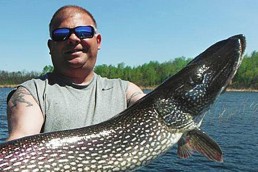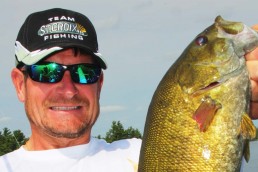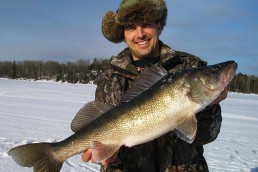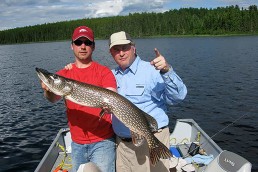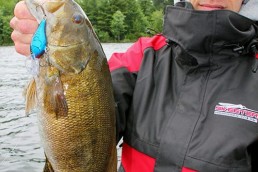Straddling Minnesota & Ontario: Rainy Lake’s World-class Fishery
The Minnesota-Ontario border at International Falls and Fort Frances serves as a crossing point for around 1 million passenger vehicles annually, with a huge number of those passengers heading north to fish and hunt in Ontario, and then returning home again.
Many hunters and fishermen cross the border and step on the gas for hours to reach other awesome destinations in Ontario that lie further north, not realizing that as they cross the Highway 11 Bridge that spans the lower reaches of Rainy Lake’s North Arm, they are bypassing some of the province’s finest fishing.
Literally within minutes of entering Ontario you find yourself on the doorstep of 275,000 acres of multi-species adventure, framed by the beauty of the Canadian Shield granite and pine landscape. Here, anglers focus on catching huge walleyes and northern pike, plus incredible numbers of smallmouth bass. Rainy Lake is well known as a U.S. fishing destination, especially for spring crappies, walleyes and smallmouth bass. What’s often overlooked is the fact that this same fishing beckons from the Canadian side, and in fact, almost 80 percent of the lake’s acreage lies in Ontario. And while some believe you have to travel into Saskatchewan or Manitoba for trophy pike potential, I’ll let you in on a little secret: Rainy Lake has some enormous northerns.
As soon as Rainy Lake is ice-free, you can target both the big northern pike and smallmouth bass with no closed seasons for these species in Ontario. If the idea of pursuing big gators in skinny water intrigues you, the shallow back bays on Rainy are numerous. First to warm in spring sunshine, the dark-bottom bays attract post-spawn monsters to recuperate and increase their metabolisms prior to feeding heavily. They will remain in these locations until the water reaches the 60-degree mark.
Rig up a stout medium 7- to 7 1/2-foot muskie rod with a fast tip (or just use a bass flippin’ stick) spooled with 20 to 30-pound-test (mono or braid). Include a small arsenal of tackle and that’s all you’ll need to succeed. Your first option should be a white or smoke-colored soft plastic stickbait or a fluke-style, such as a Berkley Jerk Shad. Any lightly weighted 5- to 7-inch minnow profile plastic will work. Rig either weightless or with a weighted number 5 swimbait hook, depending on how slowly the bait falls and how shallow the water. These back bays will be only 2 to 6 feet deep, and pike will be looking up (and feeding up) from their prone positions belly-to-the-mud.
On days with quickly warming skies and a bright sun, the heat in the water will make pike more aggressive and likely to chase bait. Have some fun with a shallow-running jerkbait, or, perhaps by slow-rolling a white spinnerbait. Or better yet, enjoy the topwater explosions by casting some surface lures. If you time your trip on a stretch of nice early spring days with sunshine, you’ll have an excellent shot at catching a 20-pound pike. The Ontario side of Rainy is loaded with them.
Spring smallmouth bass can be spectacular as well. In reality, Rainy is a top Midwest lake for smallies in all open-water months, but if you’re traveling this way in May or June for pike and walleyes, you might as well go three-for-three and add bronzebacks, too. If you find water temps below 55 degrees, break out the jerkbaits and focus your efforts on main lake points outside of spawning shorelines. Sometimes, a little wind and wave action will get the bass moving more and biting better. If you’re finding 55-plus-degree water, you might find some bass roaming the shorelines in advance of the spawn. Check southern-exposure shorelines first, and here’s why: The blustery winds associated with spring cold fronts blow predominantly from the north; most Rainy Lake smallies choose spawning beds on the lee side of inclement weather. Throw topwaters and lures like Scatter Rap Crank Shallows along these calm shorelines. Start exploring for biting bass at the entrance points to the back bays, pushing deeper in (and away from main lake points) as long as you keep contacting fish.
The outstanding fishing isn’t limited to the open-water season. Hard-water anglers will find several resorts catering to winter fishing. The benefits to traveling here this winter include the potential to catch 10- to 12-pound walleyes and northerns exceeding 20 pounds through the ice.
Whenever I’m fishing the Canadian side of Rainy Lake, I’m always astounded at the remote “feel” of this lake. Despite its ease of access, drive-to access, and wonderful accommodations at the resorts and hotels, few boats fish this vast lake. Ontario’s Rainy Lake remains a best-kept secret.
MWO
SHARE THIS POST
Did you enjoy this post?
You can be among the first to get the latest info on where to go, what to use and how to use it!
